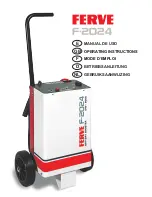
CAUTION!
After inspecting or adjusting the tire pressure, al-
ways reinstall the valve stem cap. This will prevent
moisture and dirt from entering the valve stem,
which could damage the valve stem.
Inflation pressures specified on the placard are always
“cold tire inflation pressure.” Cold tire inflation pressure
is defined as the tire pressure after the vehicle has not
been driven for at least three hours, or driven less than
1 mile (1.6 km) after a three hour period. The cold tire
inflation pressure must not exceed the maximum infla-
tion pressure molded into the tire sidewall.
Check tire pressures more often if subject to a wide range
of outdoor temperatures, as tire pressures vary with
temperature changes.
Tire pressures change by approximately 1 psi (7 kPa) per
12°F (7°C) of air temperature change. Keep this in mind
when checking tire pressure inside a garage, especially in
the winter.
Example: If garage temperature = 68°F (20°C) and the
outside temperature = 32°F (0°C) then the cold tire
inflation pressure should be increased by 3 psi (21 kPa),
which equals 1 psi (7 kPa) for every 12°F (7°C) for this
outside temperature condition.
Tire pressure may increase from 2 to 6 psi (13 to 40 kPa)
during operation. DO NOT reduce this normal pressure
build up or your tire pressure will be too low.
5
STARTING AND OPERATING
321
Summary of Contents for 2012 Challenger
Page 1: ...Challenger O W N E R S M A N U A L 2 0 1 2 3 15 11 12 35 PM ...
Page 4: ......
Page 7: ...INTRODUCTION 5 ...
Page 10: ......
Page 122: ...120 UNDERSTANDING THE FEATURES OF YOUR VEHICLE ...
Page 123: ...3 UNDERSTANDING THE FEATURES OF YOUR VEHICLE 121 ...
Page 124: ...122 UNDERSTANDING THE FEATURES OF YOUR VEHICLE ...
Page 186: ......
Page 191: ...INSTRUMENT CLUSTER 4 UNDERSTANDING YOUR INSTRUMENT PANEL 189 ...
Page 257: ...UNDERSTANDING YOUR INSTRUMENT PANEL 255 ...
Page 320: ...318 STARTING AND OPERATING ...
Page 400: ......
Page 481: ...INDEX 10 ...
Page 504: ...Chrysler Group LLC 12D491 126 AC 3rd Edition Printed in U S A ...
















































